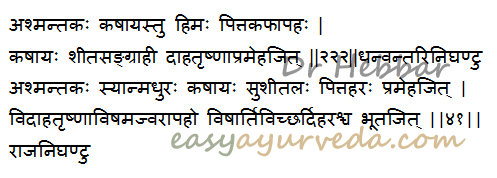Ashmantaka – Ficus rumphii – Uses, Dose, Research
Ashmantaka – Ficus rumphii is used in the treatment of peripherla neuropathy associated with diabetes, gastritis, intermittent fever, psychiatric disorders etc. Botanical name- Ficus rumphii Blume
Family- Moraceae (vata kula)
Table of Contents
Vernacular names
Names in different languages:
Hindi name-Gajanna, Gagjaira, Pakar, Kaba Pipal
English name – Mock bodh tree, Mock Peepul tree
Kannada name – Bettarli
Sanskrit Synonyms
Amlapatraka – leaves are sour in taste,
Peelupatra, Chandraka, Kushali, Valukaparna, Yamalapatraka, Induka, Kuddala, Indushaphari, Shilanta, Ambuda Pashanantaka, Vahnichandra
Chemical constituents
Ficus rumphii chemical Constituents:
B- Sitosterol, a Methoxy flavone glucoside from stem bark.
Classical categorisation
Charaka -Mutrasangrahaniya – Urine volume increasing group of herbs
Kashaya skandha – astringent group of herbs
Amla skandha – sour group of herbs
Dhanvantari Nighantu – Guduchyadi Varga
Raja Nighantu – Prabhadradi Varga
Properties, part used, dosage
Ficus rumphii medicinal Properties
Guna (qualities)- Laghu – light to digest, Rooksha – Dryness
Rasa (taste) – Kashaya – astringent
Vipaka- Katu – Undergoes pungent taste conversion after digestion
Veerya – Sheeta – Coolant
Effect on Tridosha – Balances Kapha and Pitta Dosha.
Prabhava – latex is Vamaka – emetic
Part used-Stem bark, Latex, Fruit
Dosage- Bark decoction 50-100 ml, latex 10-20 drops.
Sanskrit verse

Uses, indications
Ficus rumphii medicinal qualities:
Kashaya – Astringent
Hima – coolant
Sangrahi – absorbent, useful in diarrhea , IBS
Indicated in –
Daha – burning sensation, as in gastritis, neuropathy, burning sensation in eyes etc
Trushna – excessive thirst
Prameha – Urinary tract disorders, diabetes
Vishama Jwara – Intermittent fever
Visha – Toxic conditions, poisoning
Arti – painful conditions
Chardi – Vomiting
Bhuta – Psychiatric disorders
Usage in fomentation (sweating – Swedana) treatment:
Leaves of Ficus rumphii along with leaves of Tulsi, Castor, Moringa, radish, mustard, Vasaka, Calotropis, Jasmine, are boiled in a mud pot. The steam is directed via a pipe to the target body organs to induce sweating. This treatment is called Nadi Sweda, explained by Charaka Sutrasthana 14th chapter.
Usage for sitz bath in haemorrhoids treatment:
If there is pain in piles mass, then it is well smeared with medicated oil and patient is given sitz bath with the help of decoction prepared by boiling with leaves of Radish, Triphala, Arka – Calotropis gigantea, Varuna – Crataeva nurvala, Agnimantha – Clerodendrum phlomidis, Moringa and Ashmantaka – Ficus rumphii. –
Charaka Sutrasthana 14th chapter (Arsha – piles treatment).
As per Charaka Sutrasthana, Ashmantaka is indicated in Vamana (emesis) Panchakarma treatment.
Usage during pregnancy:
Ashmantaka is used as an ingredient to prepare herbal ghee, used during pregnancy, as per Sushruta Sharirasthana 10th chapter.
In the 2nd month of pregnancy, Ashmantaka, black sesame seeds, tamravalli and Shatavari (Asparagus racemosus) are administered. Basavarajeeyam, 16th chapter)
Sushruta has also mentioned Ashmantak as an ingredient for sweating treatment by sprinkling (Sechana). Chikitsasthana 25. He had also used it as a suturing material, along with Giloy – Tinospora cordifolia, Moorva and Shana.
For menorrhagia:
Ashmantaka kashaya is added with sugar candy and administered to the patients of asrigdara. Basavarajeeyam 16th chapter.
Interaction with medicines, supplements
Can this be used while taking Homeopathic medicine?
Yes. This product does not react with homeopathic medicine.
Can this medicine be continued while taking supplements like multivitamin tablets, Omega 3 fatty acids etc?
Yes. Generally, this product goes well with most dietary supplements. However, if you are taking more than one product per day, please consult your doctor for an opinion.
With western
medicines
Seek your
doctor’s advice if you are taking this product along with other western
(allopathic / modern) medicines. Some Ayurvedic herbs can interact with modern
medicine.
If both Ayurvedic and allopathic medicines are advised together, then it is
best to take Allopathic medicine first, wait for 30 minutes and then take the
Ayurvedic medicine.
Ayurvedic medicines
Ayurvedic medicines with Asmantak as ingredient:
Mutra Sangrahaniya Kwatha – Herbal decoction to increase urine volume
As an ingredient in preparing medicated ghee, used for treating Prameha (Urinary tract disorders, diabetes). (reference: Charaka, Prameha Chikitsa).
Sthanika Karma (Systemic Action)
Internal administration-
Digestive system – Latex induce vomiting and Fruit and bark is indicated in Helminthiasis
Respiratory system – Expels out vitiated kapha dosha. Indicated in cough and asthma
Excretory system – reduces urine output. Fruit is indicated in diabetes.
Satmikarana – It has a scraping action on the tissues. Indicated in Obesity and related disorders.









